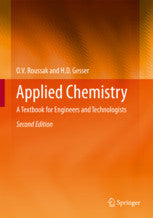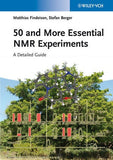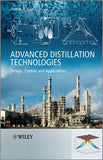Applied Chemistry : A Textbook for Engineers and Technologists by Roussak, Oleg, Gesser, H. D.
Applied Chemistry
A Textbook for Engineers and Technologists
Roussak, Oleg, Gesser, H. D.
2nd ed. 2013, XXIV, 370 p. 177 illus., 8 illus. in color.
Hardcover
- No competing book treats the Engineering aspects of Physical Chemistry in terms of Engineering design and function
- Step-by-step laboratory experiments and problems to be placed online
- Edition has newest, up-to-date and previously uncovered material
The second edition of Gesser’s classic Applied Chemistry includes updated versions of the original 16 chapters plus two new chapters on semiconductors and nanotechnology. This textbook introduces chemistry students to the applications of their field to engineering design and function across a wide range of subjects, from fuels and polymers to electrochemistry and water treatment. Each chapter concludes with a reading list of relevant books and articles as well as a set of exercises which include problems that extend the topics beyond the text. Other supplements to the text include a laboratory section with step-by-step experiments and a solutions manual for instructors.
Content Level » Graduate
TABLE OF CONTENTS :
1 Energy: An Overview........................................................................... 1
1.1 Introduction ................................................................................ 1
1.2 Renewable Energy Sources .............................................................. 8
1.3 Geothermal ................................................................................ 9
1.4 Tidal Power................................................................................ 10
1.5 Solar Energy ............................................................................... 11
1.6 Photovoltaic Cells ......................................................................... 13
1.7 Photogalvanic Cells....................................................................... 14
1.8 Wind Energy .............................................................................. 15
1.9 Hydropower ............................................................................... 16
1.10 Ocean Thermal............................................................................ 16
1.11 Wave Energy .............................................................................. 18
1.12 Osmotic Power............................................................................ 19
Further Reading ................................................................................... 22
2 Solid Fuels........................................................................................ 25
2.1 Introduction ................................................................................ 25
2.2 Wood and Charcoal....................................................................... 28
2.3 Peat......................................................................................... 28
2.4 Coal ........................................................................................ 29
2.5 Analysis of Coal ........................................................................... 29
2.6 ASTM Classification ...................................................................... 30
2.7 Ash ......................................................................................... 31
2.8 Coal and Its Environment ................................................................ 33
2.9 Fluidized Bed Combustion ............................................................... 35
2.10 Coke ........................................................................................ 35
Further Reading ................................................................................... 38
3 Crude Oil......................................................................................... 41
3.1 Introduction ................................................................................. 41
3.2 Early History ................................................................................ 41
3.3 World Production of Crude Oil ........................................................... 43
3.4 Crude Oil Processing ....................................................................... 46
3.5 Petroleum Products......................................................................... 46
3.6 Synthetic Oil................................................................................ 49
Further Reading ................................................................................... 55
4 Liquid Fuels...................................................................................... 57
4.1 Introduction ................................................................................. 57
4.2 Diesel Engine ............................................................................... 57
4.3 Diesel Fuel .................................................................................. 58
4.4 Ignition Temperature, Flash Point, Fire Point, and Smoke Point...................... 61
4.5 The Spark Ignition Internal Combustion Engine ........................................ 62
4.6 Gasoline Fuel............................................................................... 63
4.7 Grading Gasoline ........................................................................... 64
Further Reading ................................................................................... 70
5 Alternate Fuels................................................................................... 71
5.1 Introduction ................................................................................. 71
5.2 Propane ...................................................................................... 71
5.3 Methanol .................................................................................... 74
5.4 Ethanol...................................................................................... 78
Further Reading ................................................................................... 82
6 Gaseous Fuels.................................................................................... 85
6.1 Introduction ................................................................................ 85
6.2 Natural Gas................................................................................ 85
6.3 Natural Gas Uses.......................................................................... 89
6.4 Natural Gas as a Fuel..................................................................... 90
6.5 Other Carbon-Based Fuel Gases......................................................... 92
6.6 Explosion Limits.......................................................................... 93
6.7 Hydrogen .................................................................................. 93
6.8 Methods of Preparation of H2 ............................................................ 94
6.8.1 Electrolysis........................................................................ 94
6.8.2 Thermal Methods................................................................. 96
6.8.3 Natural Gas ....................................................................... 97
6.8.4 Thermal-Nuclear-Electrical ...................................................... 97
6.8.5 Photoelectrolysis .................................................................. 98
6.9 Transportation and Storage of H2 ....................................................... 98
6.10 Safety ....................................................................................... 100
6.11 Helium..................................................................................... 101
Further Reading ................................................................................... 102
7 Nuclear Energy .................................................................................. 105
7.1 Introduction ................................................................................ 105
7.2 Basis Theory of Nuclear Energy ......................................................... 105
7.3 Nuclear Model and Nuclear Reactions.................................................. 110
7.4 Radioactive Decay Rates................................................................. 111
7.5 Radioactivity Units ....................................................................... 113
7.6 Nuclear Reactors.......................................................................... 114
7.7 The Hazards of Nuclear Energy ......................................................... 120
7.8 Nuclear Waste ............................................................................. 124
7.9 Nuclear Fusion ............................................................................ 126
7.10 Summary ................................................................................... 128
Further Reading ................................................................................... 129
8 Lubrication and Lubricants................................................................... 131
8.1 An Introduction to Tribology ............................................................ 131
8.2 Gaseous Lubricants ....................................................................... 131
xiv Contents8.3 Liquid Lubricants......................................................................... 133
8.3.1 Journal Bearings.................................................................. 133
8.3.2 Thrust Bearings................................................................... 135
8.3.3 Slider Bearings .................................................................... 135
8.3.4 Ball Bearings ...................................................................... 136
8.4 Extreme Pressure Lubrication ............................................................ 137
8.5 Wear ........................................................................................ 138
8.6 Oil Additives .............................................................................. 138
8.7 Synthetic Lubricants...................................................................... 140
8.8 Solid Lubricants ........................................................................... 141
8.9 Greases..................................................................................... 143
Further Reading ................................................................................... 144
9 Electrochemistry, Batteries, and Fuel Cells................................................. 145
9.1 Introduction ................................................................................ 145
9.2 Ionics....................................................................................... 145
9.3 Electrolysis and Electrodeposition of Metals ........................................... 148
9.4 Electrochemical Machining .............................................................. 150
9.4.1 The Cathode ....................................................................... 150
9.4.2 The Electrolyte ................................................................... 151
9.5 Electrodics................................................................................. 154
9.6 Batteries and Cells........................................................................ 157
9.6.1 Primary Batteries................................................................. 157
9.6.2 Secondary Batteries .............................................................. 160
9.7 Fuel Cells .................................................................................. 163
9.8 Hybrid Cells............................................................................... 165
9.9 Electric Vehicle ........................................................................... 167
Further Reading ................................................................................... 172
10 Corrosion......................................................................................... 175
10.1 Introduction .............................................................................. 175
10.2 Factors Affecting the Rate of Corrosion .............................................. 176
10.3 Types of Corrosion ...................................................................... 179
10.3.1 Uniform Corrosion ............................................................ 179
10.3.2 Bimetallic Corrosion .......................................................... 179
10.3.3 Crevice Corrosion ............................................................. 180
10.3.4 Pitting Corrosion ............................................................... 180
10.3.5 Grain Boundary Corrosion .................................................... 182
10.3.6 Layer Corrosion ................................................................ 182
10.3.7 Stress Corrosion Cracking .................................................... 182
10.3.8 Cavitation Corrosion .......................................................... 183
10.3.9 Hydrogen Embrittlement ...................................................... 184
10.4 Atmospheric Corrosion ................................................................. 184
10.5 Corrosion in Soil ......................................................................... 185
10.6 Aqueous Corrosion ...................................................................... 185
10.7 Corrosion Protection and Inhibition ................................................... 186
10.8 Corrosion in Boiler Steam and Condensate ........................................... 187
10.9 Cathodic Protection ...................................................................... 188
Further Reading ................................................................................... 189
11 Polymers and Plastics........................................................................... 191
11.1 Introduction .............................................................................. 191
11.2 Molecular Weight ....................................................................... 191
11.3 Copolymers .............................................................................. 194
11.4 Classification of Polymers .............................................................. 194
11.4.1 Addition Polymers ........................................................... 195
11.4.2 Condensation Polymers ...................................................... 195
11.5 Vinyl Polymers .......................................................................... 196
11.5.1 Polyethylene .................................................................. 197
11.5.2 Polypropylene ................................................................ 197
11.5.3 Polyvinyl Chloride ........................................................... 198
11.5.4 Polyvinylidene Chloride ..................................................... 198
11.5.5 Polystyrene .................................................................... 199
11.5.6 Polyacrylonitrile .............................................................. 199
11.5.7 Polymethyl Methacrylate .................................................... 199
11.5.8 Polyvinyl Acetate, Polyvinyl Alcohol ...................................... 200
11.5.9 Polytetrafluoroethylene or Teflon ........................................... 200
11.6 Condensation Polymers................................................................. 202
11.6.1 Nylon .......................................................................... 202
11.6.2 Polyester ...................................................................... 202
11.6.3 Polycarbonates and Epoxides ............................................... 203
11.7 Thermosetting Polymers ................................................................ 203
11.7.1 Phenol Formaldehyde (Bakelite)........................................... 204
11.7.2 Urea Formaldehyde .......................................................... 205
11.7.3 Polyurethane .................................................................. 205
11.8 Glass Transition Temperature .......................................................... 206
11.9 Elastomers................................................................................ 208
11.10 Mechanical Strength of Plastics........................................................ 211
11.11 Fire Retardants in Plastics .............................................................. 213
Further Reading ................................................................................... 216
12 Adhesives and Adhesion........................................................................ 219
12.1 Introduction .............................................................................. 219
12.2 Classification and Types of Adhesives ................................................ 220
12.3 The Adhesive Joint...................................................................... 220
12.4 The Theory of the Adhesive Bond ..................................................... 223
12.4.1 Mechanical Interlocking ..................................................... 223
12.4.2 Diffusion Theory ............................................................. 223
12.4.3 Electrostatic Theory .......................................................... 224
12.4.4 Adsorption Theory ........................................................... 224
12.5 Chemistry of Selected Adhesives ........................................................ 225
Further Reading ................................................................................... 232
13 Paint and Coatings.............................................................................. 233
13.1 Introduction .............................................................................. 233
13.2 Constituents of Paint and Coatings .................................................... 233
13.3 Binder ..................................................................................... 233
13.4 Driers..................................................................................... 235
13.5 Pigment................................................................................... 236
13.6 Solvents: Thinners ....................................................................... 237
13.7 Water-Based Paints ....................................................................... 238
13.8 Protective Coatings ....................................................................... 238
13.9 Surface Preparation ....................................................................... 240
13.10 Specialized Coatings...................................................................... 240
13.10.1 Formaldehyde Resins................................................................ 240
13.11 Fire Retardant Paints ...................................................................... 242
13.12 Antifouling Paints......................................................................... 242
Further Reading ................................................................................... 243
14 Explosives......................................................................................... 245
14.1 Introduction ................................................................................ 245
14.2 Primary Explosives ....................................................................... 245
14.3 Secondary Explosives .................................................................... 247
14.3.1 Chemical Stability ............................................................. 247
14.3.2 Sensitivity to Ignition ......................................................... 247
14.3.3 Sensitivity to Detonation ...................................................... 249
14.3.4 Velocity of Detonation ........................................................ 249
14.3.5 Explosive Strength ............................................................. 249
14.4 Oxygen Balance ........................................................................... 250
14.5 Modern Explosives ....................................................................... 250
14.5.1 Nitroglycerin ................................................................... 251
14.5.2 Trinitrotoluene (TNT)......................................................... 251
14.5.3 Tetryl ........................................................................... 251
14.5.4 Ammonium Nitrate, NH4NO3 ................................................ 252
14.5.5 Hexogen ........................................................................ 252
14.6 Applications............................................................................... 253
14.6.1 Propellants ...................................................................... 254
14.6.2 Pyrotechnics .................................................................... 254
14.6.3 Metalworking .................................................................. 254
14.6.4 Riveting ......................................................................... 256
14.7 Accidental Explosions.................................................................... 256
Further Reading ................................................................................... 260
15 Water .............................................................................................. 261
15.1 Introduction ................................................................................ 261
15.2 Natural Water ............................................................................. 265
15.2.1 Turbidity ........................................................................ 265
15.2.2 Color............................................................................ 266
15.2.3 Odor and Taste ................................................................. 266
15.3 Water Sterilization ........................................................................ 266
15.3.1 Chlorine ........................................................................ 266
15.3.2 Ozone ........................................................................... 267
15.4 Infectious Agents .......................................................................... 268
15.5 Water Quality: Hardness ................................................................. 269
15.6 Water Softening ........................................................................... 271
15.6.1 Ion Exchange ................................................................... 271
15.6.2 Reverse Osmosis ............................................................... 272
15.6.3 Electrocoagulation ............................................................. 272
15.6.4 Electrodialysis ................................................................. 273
15.7 Boiler Scale ................................................................................ 274
15.8 Wastewater ................................................................................ 275
Further Reading ................................................................................... 277
16 Carbon-Based Polymers, Activated Carbons............................................... 279
16.1 Introduction ................................................................................ 279
16.2 Polymeric Carbon: Diamond ............................................................. 279
16.3 Polymeric Carbon: Graphite ............................................................. 280
16.4 Graphene ................................................................................... 281
16.4.1 Density of Graphene ............................................................ 283
16.4.2 Optical Transparency of Graphene ............................................ 283
16.4.3 Strength of Graphene ........................................................... 283
16.4.4 Electrical Conductivity of Graphene .......................................... 284
16.4.5 Thermal Conductivity of Graphene ........................................... 284
16.5 Activated Carbons ........................................................................ 284
Further Reading ................................................................................... 290
17 Cement, Ceramics, and Composites.......................................................... 291
17.1 Introduction ................................................................................ 291
17.2 Cement Nomenclature .................................................................... 292
17.3 Manufacture of Portland Cement........................................................ 292
17.4 Setting of Cement ......................................................................... 293
17.5 Concrete .................................................................................... 295
17.6 Ceramics................................................................................... 295
17.6.1 Composites ...................................................................... 297
Further Reading ................................................................................... 300
18 Semiconductors and Nanotechnology ........................................................ 303
18.1 Semiconductors ........................................................................... 303
18.1.1 Introduction ...................................................................... 303
18.2 The Triode ................................................................................. 303
18.3 Applications............................................................................... 305
18.4 Optical Effects ............................................................................. 306
18.5 Nanotechnology ........................................................................... 307
Further Reading ................................................................................... 309
19 Epilogue ........................................................................................... 311
Further Reading ................................................................................... 312
Appendix A: Fundamental Constants and Units................................................. 313
Appendix B: Viscosity ................................................................................ 317
Appendix C: Surface Chemistry .................................................................... 325
Appendix D: Patents................................................................................. 337
Appendix E: Experiments............................................................................ 343
Experiments 1 ........................................................................................... 343
Experiments 2 ........................................................................................... 350
Experiments 3 ........................................................................................... 351
Experiments 4 ........................................................................................... 352
Experiments 5 ........................................................................................... 353
xviii ContentsExperiments 6 ........................................................................................... 355
Experiments 7 ........................................................................................... 356
Experiments 8 ........................................................................................... 361
Index ........


















